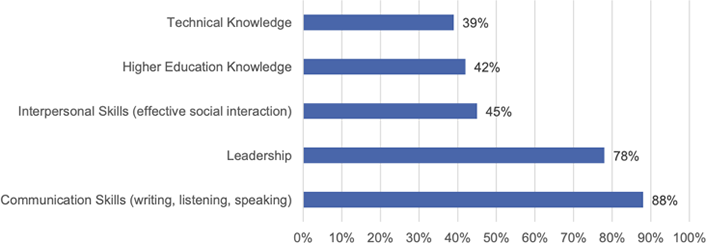There has never been a better time for technology leaders to shine and show their C-suite versatility. Enter the new role of CIO+.

Throughout a career, it is common to ask oneself: "What's next?" In many occupations, a career progression is clear, even if it is highly competitive—take, for example, the path of academic leaders who progress from faculty to chair, dean to provost, and finally (perhaps) on to president. But what's next for a CIO? There isn't always a straight line to the CIO job, and what lies beyond can be just as uncertain.
In the past, CIOs who wanted to progress had to change jobs, switch industries, or begin consulting. But as technology has grown to play a critical role in the operations of higher education, and as the CIO role has advanced within the institutional hierarchy, opportunities are opening up for CIOs to be utility players, jumping in to address leadership needs throughout a college or university. Enter the "CIO+"—a new kind of executive who blends the versatility and resilience demanded by the continuously changing landscape of information technology with the business savvy and entrepreneurial mindset required to help higher education institutions thrive under today's intense pressures.
As the CIO role has grown from technical management to include innovation and change leadership, some CIOs are now uniquely positioned to move into new functions across the institution. Necessarily, CIOs have uniquely broad insight into campus-wide operations—developed through work with diverse colleagues to translate business issues into technical solutions. CIOs have learned to take time and deeply understand the ins-and-outs of almost any business unit, traveling readily from student services to academic affairs to administrative operations—and so many places in between.
For decades, CIOs have led their organizations through tremendous change and disruption—from the advent of mobile computing and the rise of cloud technology to the introduction of HIPAA and PCI regulatory compliance. Along the way, the scope of IT organizations has continually evolved to include functions like project management, information security, service management, business continuity—the list goes on. In a sense, the job has always been about doing something today that is different from what was done yesterday. CIOs are adaptable leaders good at planning, logistics, budgeting, and strategy. In a 2018 survey, 60 percent of respondents stated that the main reason for pursuing the CIO role is "to make a difference." They also noted that the most important skills for a CIO are communication and leadership (see figure 1).1

Source: Wayne A. Brown, Higher Education Technology: The Chief Information Officer and Technology Leader (Albany, NY: Center for Higher Education CIO Studies, 2018), p. 39. Reprinted with permission.
Still, there are many barriers that, without careful thought and positioning, can make taking on additional functions difficult for a CIO.
First, information technology is simply big—the scope is broad, the pace is fast, and the demands are high. With compliance, information security, and IT governance, CIOs who themselves—or whose teams—lack the right blend of talent and organizational maturity will be challenged to handle the context switching and other demands associated with adding responsibilities outside of the IT organization. Additionally, a CIO+ may not make sense for every campus. For example, institutions whose core offerings are primarily digital (e.g., online education) increasingly call on CIOs to take on other significant "front office" technology responsibilities, such as digital product development and product management.
Second, many outside of information technology may be uncomfortable with the idea that a CIO should take on more responsibility beyond the IT organization. Some institutions have made a single executive responsible for the IT department and libraries, but otherwise the status quo dictates where so many other functions report in. And yet, as information technology has evolved over decades (remember when academic computing and administrative computing were separate entities?), and as IT leaders have become CIOs reporting to chief executives, other functions have also experienced major shifts. But organizational structures in those areas often remain unchanged. As a result, the CIO's peers, executive and board leaders, and others on campus may be biased against the unfamiliar idea of a CIO breaking the mold and taking on more.
This presents a two-part challenge if you are a CIO looking to contribute in new ways. Others on campus will need to witness your versatility. You must be viewed as having enterprise-level understanding, experience, and expertise. Think about how you can solve enterprise problems for which the solutions may not be technical. Demonstrate that you can deliver results in areas that may surprise those around you, challenging their assumptions. A great way to begin building this type of reputation is to serve on committees and initiatives outside of the traditional IT realm.
As you navigate the road beyond a traditional CIO role, be sure to steer clear of some basic pitfalls. First, don't move too soon. If we're in our jobs "to make a difference," as those survey respondents claimed, then we want to see our major tech-related initiatives succeed. Angling for the next big challenge before you reach those milestones within technology will go one of two ways: either those around you won't buy that you've mastered your own domain, or you may simply get in over your head.
Second, don't give your colleagues a reason to mistake you as devious or opportunistic. Without their buy-in, you may not make it to the next stop—and even if you do, your chances of success will be compromised. Instead, focus on laying the groundwork for trust in your authentic integrity and ability. If you're in a "race to the top," take the high road: employ the careful balance of thoughtfulness and hard work the CIO role has given you.
Finally, think intently and boldly about how to structure your IT organization. This is a long game—and it must be totally aligned with the future success of information technology at your institution. One analyst at Gartner says to "structure IT like a service provider."2 This translates into the following steps:
- Build an IT leadership role that mirrors some of the C-level roles in any major enterprise (e.g., CFO, COO, and CTO).
- Create an IT Business Office (the CFO column) that will streamline the many complex commercial and financial matters that the IT organization must handle to be successful and agile.
- Identify or cultivate strong operational leadership within the IT organization (the COO column), giving the organization real-time leadership that provides reliability and response during normal operations and minimizes fallout during a crisis.
As you arrive at your new CIO+ destination, be ready for a few surprises, and consider these lessons we learned along the way.
First, your view of a team through an external lens can be very different from the view you will get from the inside. It is easy to be critical and think you have all the answers until you gain an insider perspective. Then, as you learn more and become a part of the team, you may become protective of the group. Try to maintain objectivity and revisit the external lens as you are evaluating and contemplating change. Both perspectives are valuable—and you may want to rely on a trusted colleague who can provide you with occasional reality checks.
When a new responsibility is added, prepare yourself and those around you so that you can let go of something. This is a great time to provide others with the chance to grow and to identify their own new ways to develop an organization. It is also an excellent time to reorganize and break free from stale IT organizational structures.
Avoid empire-building as a goal, and instead focus on balanced leadership so that you can truly contribute and make a difference. Stay concentrated on the output, performance, and results of each area. If you are approaching a tipping point where you are becoming less effective, be prepared to speak up! Only you really know when enough is enough, and you may find yourself depending on those around you in new ways—not just your team but also your peers, your advisors, and possibly even your boss. Remember too that when you take on something new, others on your team may also be taking on significant additional responsibility. For example, your business office may suddenly have a much larger budget to manage, more purchasing to handle, and/or added HR responsibilities to coordinate. Increase dialogue with and support for your team, or you will risk responding too late to their needs.
Take time to consider and understand why you received this new responsibility. What is it that made you successful? Is the change right for both you and the institution? Be self-critical of the opportunity, and edit where analysis suggests editing is needed. It's okay to say "no." If you do say "yes," build on your success and continue to minimize your weaknesses, but be flexible in acknowledging that what got you here might not be what makes you successful in the future.
Taking into consideration all of the above, remember that nobody knows better than you when the right time is right to take on that next big challenge and become a CIO+. A safe bet, though, is that now is a good time to demonstrate your interest. Talk to those around you to signal that you are excited not just about your current job but about the enterprise more broadly. You might be surprised to learn that your colleagues have trust in your abilities beyond what you're doing today. One or two of them may even have projects that they would like you to help lead. You won't know this without having a conversation.
There has never been a better time for technology leaders to shine and to show their C-suite versatility. The possibilities are many, and only you and the people close to you know what unique opportunities are right for you to pursue. Take it slowly, focus on output, cultivate accountability and leadership in the IT organization, and demonstrate your skills along the way. Before long, you may find yourself blazing trails and turning heads in your second career as a CIO+.
Notes
- Wayne A. Brown, Higher Education Technology: The Chief Information Officer and Technology Leader (Albany, NY: Center for Higher Education CIO Studies, 2018), pp. 38–39. ↩
- Monika Sinha, "How to Structure IT Like a Service Provider," Gartner (website), October 11, 2018. ↩
Sharon Blanton is Vice President for Information Technology and Campus Safety at The College of New Jersey.
Carlos García is Vice President for Technology and Human Resources at Vassar College.
EDUCAUSE Review 55, no. 2 (2020)
© 2020 Sharon Blanton and Carlos García
